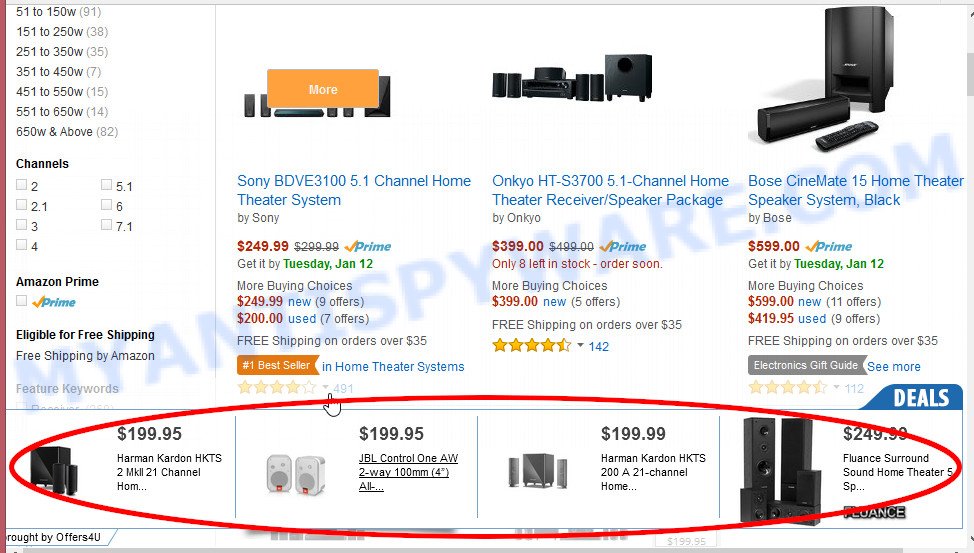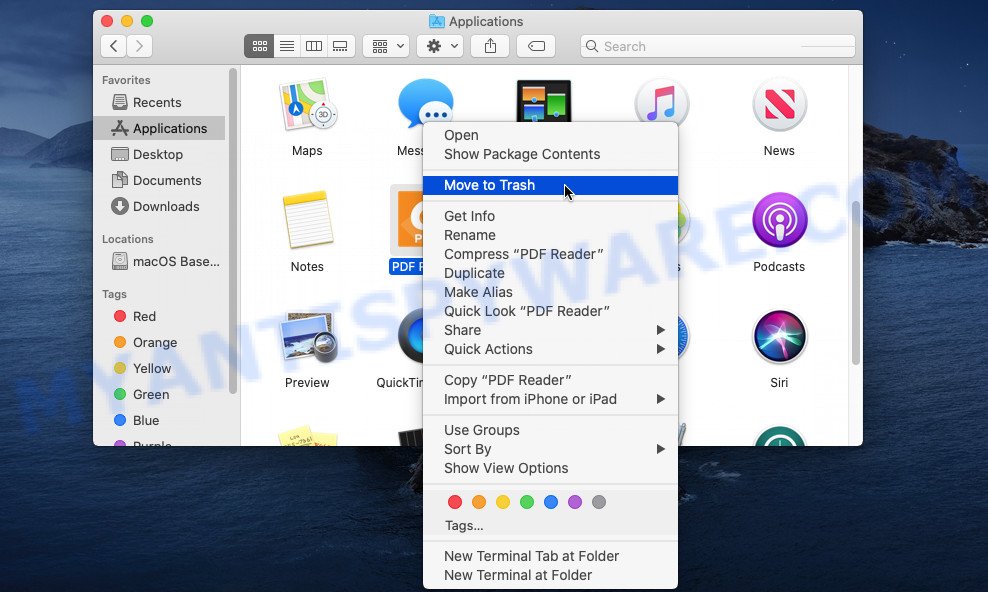What is UnitNetwork
UnitNetwork is an malicious application that acts as adware. Adware is a type of malicious software that’s designed to bombard you with endless advertisements and popup windows that could potentially be dangerous for your machine. UnitNetwork app can display unwanted ads, change browser settings, redirect web-browser to scam pages, install harmful browser extensions.

Unwanted ads
Does adware steal your privacy data? The UnitNetwork adware can gather your Web browsing activity by saving URLs visited, IP addresses, browser version and type, cookie information, Internet Service Provider (ISP) and web sites visited. Such kind of behavior can lead to serious security problems or user information theft. This is another reason why the adware should be removed as quickly as possible.
Adware is usually written in ways common to malicious software, spyware and hijackers. In order to delete UnitNetwork adware, you will need perform the following steps or use free adware removal tools listed below.
How does UnitNetwork get on your machine
The majority of adware gets on Mac computers together with free or even paid software which Internet users can easily download online. The installers of such applications, most commonly, clearly display that they will install bundled software. The option is given to users to block the install of any optional apps. So, in order to avoid the setup of any adware: read all disclaimers and install screens very carefully, choose only Custom or Advanced installation mode and reject all optional programs in which you are unsure.
Threat Summary
| Name | UnitNetwork, “UnitNetwork 1.0 app” |
| Type | adware, PUP (potentially unwanted program), Mac malware, Mac virus |
| Detection Names | Adware.MAC.Generic, Osx.Adware.Cimpli, Trojan-Downloader.OSX.Adload, ApplicUnwnt, Adware/Adload!OSX, MacOS.Agent-MT, Program:MacOS/Vigram.A and OSX.Trojan.Gen |
| Distribution | Freeware installers, fake update tools, dubious pop up advertisements and torrent downloads |
| Symptoms | The website links redirect to a web pages different from what you expected, advertising popups won’t go away, new entries appear in your Applications folder, new toolbars suddenly installed on your web-browser, your browser home page has changed without your permission, low ping but slow Internet. |
| Removal | UnitNetwork removal guide |
How to remove UnitNetwork from Mac computer
There are several steps to removing the UnitNetwork adware, because it installs itself so deeply into the MAC. You need to remove all suspicious and unknown applications, then get rid of harmful addons from the Google Chrome, Firefox and Safari and other browsers you’ve installed. Finally, you need to reset your web browser settings to remove any changes the adware has made, and then scan your MAC system with MalwareBytes Anti-Malware (MBAM) to ensure the adware software is fully removed. It will take a while.
To remove UnitNetwork, complete the steps below:
- Remove unwanted profiles on Mac device
- Remove UnitNetwork related software through the Finder
- Remove UnitNetwork related files and folders
- Scan your Mac with MalwareBytes
- Remove UnitNetwork from Safari, Chrome, Firefox
- How to stay safe online
Remove unwanted profiles on Mac device
UnitNetwork can make changes to the Mac system such as malicious changes to browser settings, and the addition of malicious system profiles. You need to check the system preferences, find and remove malicious profiles and ensure your settings are as you expect.
Click the System Preferences icon ( ![]() ) in the Dock, or choose Apple menu (
) in the Dock, or choose Apple menu ( ![]() ) > System Preferences.
) > System Preferences.

In System Preferences, click Profiles, then select a profile related to UnitNetwork.

Click the minus button ( – ) located at the bottom-left of the Profiles screen to remove the profile.
Note: if you do not see Profiles in the System Preferences, that means there are no profiles installed on your Mac, which is normal.
Remove UnitNetwork related software through the Finder
Go to the Finder and uninstall dubious programs, all applications you do not remember installing. It is important to pay the most attention to applications you have recently installed. If you do not know what a program does, look for the answer on the World Wide Web.
Open Finder and click “Applications” like below.

You will see a list of applications installed on your MAC system. We recommend to pay maximum attention to the program you installed last. Most likely, it’s the UnitNetwork . If you are in doubt, you can always check the program by doing a search for her name in Google, Yahoo or Bing.

After the program which you need to delete is found, simply right click on its name, and select “Move to Trash”.
Don’t forget, choose Finder, then “Empty Trash”.
Remove UnitNetwork related files and folders
Now you need to try to find UnitNetwork related files and folders, and then delete them manually. You need to look for these files in certain directories. To quickly open them, we recommend using the “Go to Folder…” command.
UnitNetwork creates several files, these files must be found and removed. Below is a list of files associated with this unwanted application.
- /Library/LaunchDaemons/com.UnitNetwork.system.plist
- ~/Library/LaunchAgents/com.UnitNetwork.service.plist
- /Library/Application Support/.(RANDOM)/System/com.UnitNetwork.system
- ~/Library/Application Support/.(RANDOM)/Services/com.UnitNetwork.service.app
Some files created by UnitNetwork are hidden from the user. To find and delete them, you need to enable “show hidden files”. To do this, use the shortcut CMD + SHIFT + . Press once to show hidden files and again to hide them. There is another way. Click Finder -> Applications -> Utilities -> Terminal. In Terminal, paste the following text: defaults write com.apple.finder AppleShowAllFiles YES

Press Enter. Hold the ‘Option/alt’ key, then right click on the Finder icon in the dock and click Relaunch.

Click on the Finder icon. From the menu bar, select Go and click “Go to Folder…”. As a result, a small window opens that allows you to quickly open a specific directory.

Check for UnitNetwork generated files in the /Library/LaunchAgents folder

In the “Go to Folder…” window, type the following text and press Go:
/Library/LaunchAgents

This will open the contents of the “/Library/LaunchAgents” folder. Look carefully at it and pay special attention to recently created files, as well as files that have a suspicious name. Move all suspicious files to the Trash. A few examples of files: com.machelper.plist, com.net-preferences.plist, installapp.plist, com.UnitNetwork.service.plist, macsearch.plist, search.plist and com.google.defaultsearch.plist, . Most often, browser hijackers, adware software and PUPs create several files with similar names.
Check for UnitNetwork generated files in the /Library/Application Support folder

In the “Go to Folder…” window, type the following text and press Go:
/Library/Application Support

This will open the contents of the “Application Support” folder. Look carefully at its contents, pay special attention to recently added/changed folders and files. Check the contents of suspicious folders, if there is a file with a name similar to com.UnitNetwork.system, then this folder must be deleted. Move all suspicious folders and files to the Trash.
Check for UnitNetwork generated files in the “~/Library/LaunchAgents” folder

In the “Go to Folder…” window, type the following text and press Go:
~/Library/LaunchAgents

Proceed in the same way as with the “/Library/LaunchAgents” and “/Library/Application Support” folders. Look for suspicious and recently added files. Move all suspicious files to the Trash.
Check for UnitNetwork generated files in the /Library/LaunchDaemons folder
In the “Go to Folder…” window, type the following text and press Go:
/Library/LaunchDaemons

Carefully browse the entire list of files and pay special attention to recently created files, as well as files that have a suspicious name. Move all suspicious files to the Trash. A few examples of files to be deleted: com.search.system.plist, com.UnitNetwork.system.plist, com.installapp.system.plist, com.machelper.system.plist and com.macsearch.system.plist. In most cases, adware, browser hijackers and potentially unwanted programs create several files with similar names.
Scan your Mac with MalwareBytes
Manual UnitNetwork removal requires some computer skills. Some files and system entries that created by the adware can be not completely removed. We suggest that run MalwareBytes Free to scan the Mac computer. Moreover, this program will help you to delete adware, PUPs, browser hijackers and toolbars that your MAC OS may be affected too.

- Installing the MalwareBytes AntiMalware is simple. First you’ll need to download MalwareBytes Anti-Malware from the following link. Save it on your Microsoft Windows desktop or in any other place.
Malwarebytes Anti-malware (Mac)
21177 downloads
Author: Malwarebytes
Category: Security tools
Update: September 10, 2020
- Once downloading is finished, please close all programs and open windows on your computer. Run the downloaded file. Follow the prompts.
- The MalwareBytes Free will open and display the main window.
- Further, click the “Scan” button . MalwareBytes Free application will scan through the whole MAC OS for the UnitNetwork adware. This task can take some time, so please be patient. When a malicious software, adware software or potentially unwanted software are detected, the number of the security threats will change accordingly. Wait until the the checking is finished.
- Once MalwareBytes Anti Malware has finished scanning your Apple Mac, a list of all threats detected is produced.
- All found items will be marked. You can remove them all by simply click the “Remove Selected Items” button.
- Close the Anti Malware and continue with the next step.
Remove UnitNetwork from Safari, Chrome, Firefox
If you have ‘UnitNetwork adware software’ removal problem, then remove unwanted extensions can help you. In the steps below we will show you the solution to get rid of harmful extensions without reinstall. This will also help to get rid of UnitNetwork adware from your browser.
You can also try to remove UnitNetwork adware by reset Google Chrome settings. |
If you are still experiencing issues with UnitNetwork adware removal, you need to reset Mozilla Firefox browser. |
|
How to stay safe online
Run ad-blocker application like AdGuard in order to stop advertisements, malvertisements, pop-ups and online trackers, avoid having to install malicious and adware browser plug-ins and add-ons which affect your MAC system performance and impact your machine security. Surf the Internet anonymously and stay safe online!

Visit the page linked below to download the latest version of AdGuard for Mac OS.
3892 downloads
Author: © Adguard
Category: Security tools
Update: January 17, 2018
Once the downloading process is finished, start the downloaded file. You will see the “Setup Wizard” screen. Follow the prompts.
Each time, when you run your MAC system, AdGuard will start automatically and stop intrusive ads, block harmful and misleading web-pages.
Finish words
After completing the steps above, your machine should be clean from this adware and other malicious software. The Google Chrome, Safari and Firefox will no longer show intrusive UnitNetwork ads when you surf the World Wide Web. Unfortunately, if the steps does not help you, then you have caught a new adware software, and then the best way – ask for help.
Please create a new question by using the “Ask Question” button in the Questions and Answers. Try to give us some details about your problems, so we can try to help you more accurately. Wait for one of our trained “Security Team” or Site Administrator to provide you with knowledgeable assistance tailored to your problem with the annoying UnitNetwork .


















